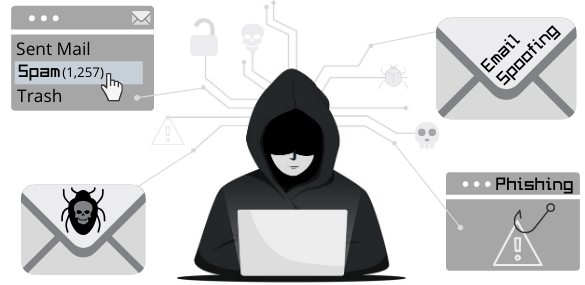Email Security for Organizations: Phishing Protection & Employee Training
Email remains one of the most vital tools for modern businesses, but it’s also one of the most targeted by cybercriminals. From phishing scams to...
2 min read
Peter Ricks : Feb 13, 2025 11:02:38 AM

Cybercriminals are getting smarter. One of the most dangerous threats to businesses today is Business Email Compromise (BEC)—a sophisticated scam where attackers impersonate trusted figures to manipulate employees into transferring money or sharing sensitive data. Unlike mass phishing attacks, BEC is highly targeted, exploiting trust and authority to bypass security measures.
BEC often involves email spoofing, where an attacker forges an email address to make it look like it’s coming from a legitimate source. It also relies on social engineering tactics, such as urgency and authority, to pressure employees into acting without thinking. Understanding these tactics is the first step in preventing BEC attacks.
Attackers use several methods to infiltrate businesses. The most common include:
BEC scams can be highly convincing, often appearing as routine business communications from trusted sources. However, there are key warning signs that can help employees and organizations identify and stop these attacks before any damage is done.
✅ Email Spoofing – Check the sender's address carefully. Attackers may change one letter in the domain (e.g., john.doe@examp1e.com instead of john.doe@example.com). Learn about email spoofing on our blog.
✅ Unusual requests – Be cautious if a payment or sensitive information request comes out of nowhere, especially if it’s urgent or outside normal procedures.
✅ Urgency and pressure – BEC emails often demand immediate action, discouraging employees from verifying details.
✅ Changes in communication style – If an executive or vendor suddenly communicates differently (e.g., tone, grammar, unusual wording), it could be a red flag.
✅ Requests for secrecy – Attackers may insist that employees don’t speak to anyone else about a request, claiming confidentiality.
Business Email Compromise (BEC) attacks are designed to exploit trust, authority, and urgency. To guard your organization against these costly and damaging scams, it’s essential to adopt a multi-layered approach that combines employee awareness, technical defenses, and strong internal procedures. Here are key proactive measures to keep your business safe:
🔹 Train Your Employees Regularly – Teach your team how to recognize BEC attempts, phishing scams, and email spoofing. Learn more about phishing on our blog.
🔹 Verify Requests Independently – Before making payments or sharing data, confirm requests using a secondary communication channel, such as a direct phone call.
🔹 Implement Multi-Factor Authentication (MFA) – Require MFA for accessing business email accounts to prevent unauthorized access.
🔹 Use email authentication protocols – Configure SPF, DKIM, and DMARC to detect and block email spoofing attempts.
🔹 Restrict sensitive information sharing – Limit publicly available data about executives, vendors, and financial processes to prevent attackers from gathering intelligence.
🔹 Establish financial controls – Require multiple approvals for significant transactions and verify any changes to vendor banking details through official channels.
BEC attacks can cost businesses millions of dollars, but with strong security measures and employee awareness, you can reduce the risk. Don’t let cybercriminals exploit trust—educate, verify, and secure your systems.
For more cybersecurity insights, explore:
➡ Just What Is Email Spoofing?
➡ What Is Phishing & When You’re Phished
Need help securing your business against BEC threats? Download our infographic: Beware of BUSINESS EMAIL COMPROMISE RECOGNIZING: We help you combat advanced cyberattacks.

Email remains one of the most vital tools for modern businesses, but it’s also one of the most targeted by cybercriminals. From phishing scams to...

So you’re here because you are concerned about email spoofing. Have you ever received an email from one of your company’s executives asking you to...

In today's digital landscape, where cyber threats loom large, businesses must fortify their defenses against ever-evolving dangers. Despite hefty...